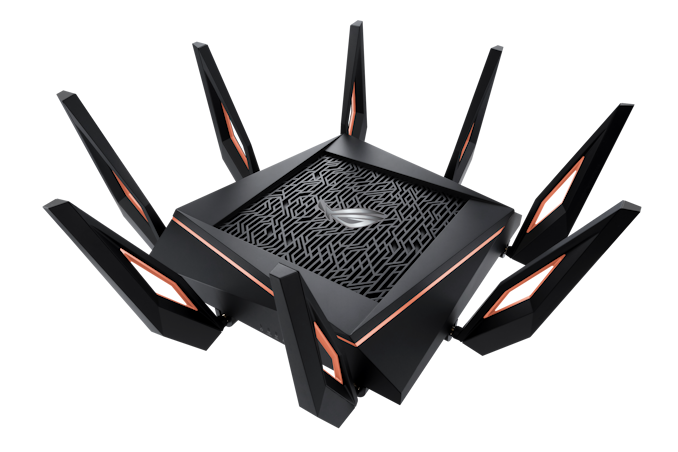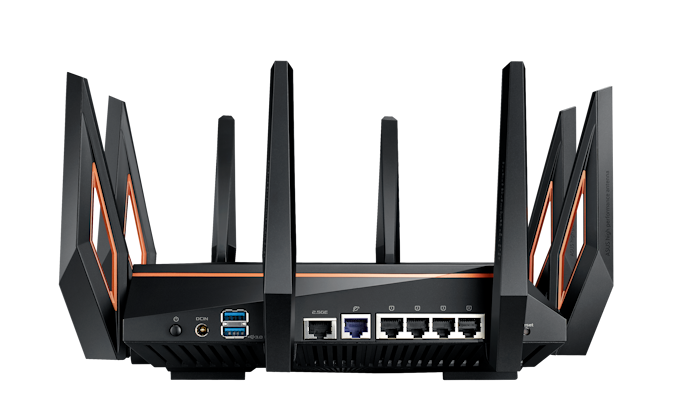AT 101: Wi-Fi 6 And Why You Want It
by Brett Howse on February 12, 2020 8:00 AM ESTThe 2020 AnandTech Wi-Fi Test Bed
We’ve been comfortably using Wi-Fi 5 for some time now, and it is only in the last several months that laptops have been shipping with Wi-Fi 6 based networking, mostly thanks to Intel’s Project Athena which has a requirement of the Intel AX200 Wi-Fi module, which is Intel's first Wi-Fi 6 based module on the market. Previously almost all shipping laptop computers offered Wi-Fi 5, and even a few with the latest Intel wireless adapters such as the Wireless-AC 9260 offered the advanced Wi-Fi 5 options such as 160 Mhz channel width, and MU-MIMO, so its nice to see a move to a new standard which includes these benefits across the board.
Although there are now quite a few Wi-Fi 6 routers and access points on the market, we had some specific criteria to meet. The router had to support Wi-Fi 6, and the 160 MHz channels, but because we are testing for performance, and not for capacity, we need an access point with a multi-Gigabit Ethernet connection. A typical laptop with a 2x2:2 network connection will be connecting to the access point at 2.4 Gbps, so transferring files from Ethernet over Gigabit will be a bottleneck. This does limit the selection somewhat.
After evaluating several models, we decided on the ASUS ROG Rapture GT-AX11000. The name is a mouthful, but meets all of our criteria and more. Most importantly, it offers the coveted 2.5 GbE port.
The ASUS ROG Rapture GT-AX11000
As the name implies, this router from ASUS can support up to 11000 Mbps over wireless, thanks to the 4x4 2.4 GHz, offering 1148 Mbps, and the two 4x4 5 GHz networks each offering 4804 Mbps. This adds up to just under 11000 Mbps, although with wireless the maximum connection speed is pretty much impossible to achieve. With the two separate 5 GHz networks, you can easily split off your consumption devices with higher priority devices, reducing interference on each network.
On the Wide Area Network (WAN) side there is a single 1 Gbps connection, and on the Local Area Network (LAN) side there are four 1 GbE and the single 2.5 GbE connection.
This router is built for capacity, with eight external antennae, and being a gaming router it also offers plenty of RGB lighting options. For those that don’t need the lighting, it can be turned off. ASUS also some tools to change the priority of gaming packets to reduce latency, assuming your network is that busy, and specifically prioritizes traffic from other ROG devices to make setup as easy as possible. ASUS even includes a utility to ping the various game servers for popular multiplayer games to provide you a map of latency to each one.
The GT-AX11000 also integrates with the ASUS AiMesh networking equipment to provide a whole-home mesh network, if even a router of this size can’t cover the entire house, either due to size or building materials blocking the signal.
For testing, the router is used in the access point mode, with the LAN connecting being over the 1 Gbps Ethernet, and a server connected directly to the router in the 2.5 Gbps port.













149 Comments
View All Comments
Impulses - Thursday, February 13, 2020 - link
Is internet that fast really only available to 10% of the US population or was that an off the cuff "stat"...I'm surprised it's still that bad if that's accurate, I used to weep along with everyone else when I'd see comments like this but I've had 1Gbps (up/down) fiber at home for over a year now in a US territory that isn't exactly known for having it's stuff/infrastructure together (Puerto Rico)... For $70/month, no clue how competitive that is but it's affordable enough for me and well worth it (nor any more expensive than a lower speed package from the cable ISP).
Cable company is doing it's own fiber rollout to compete and they already offer 500Mbps over coax (tho 250-300Mbps is really what's sanely priced, the premium for the top tier isn't worth it). I was actually complacent with my 250mbps service with them but I'm glad to see some competition in the market.
Obviously those services aren't available island wide tho, I really dunno what % the rollouts are at... The fiber ISP has taken an interesting approach where they poll neighborhoods to decide where to build next.
oynaz - Friday, February 14, 2020 - link
1Gbps internet is around 50 euro/month in quite a few parts of Europe.Makaveli - Wednesday, February 12, 2020 - link
The GT-AX11000 has a 2.5Gbps port that can be turn into a WAN Port.YB1064 - Wednesday, February 12, 2020 - link
I see this as a potential problem:"The devices would adapt their power levels for transmission to avoid them actively interfering with each others’ transmissions."
evilspoons - Wednesday, February 12, 2020 - link
It's like two people starting to talk to friends with them in a soft voice instead of shouting louder and louder and making both conversations impossible to understand.Xyler94 - Wednesday, February 12, 2020 - link
That's how enterprise gear works, it's to avoid interference, which is worse than modulating power. boosting signal introduces noise, the less boosting you need to do, the better.Whiteknight2020 - Wednesday, February 12, 2020 - link
Because who has greater than 1Gbit ISP connections?Makaveli - Wednesday, February 12, 2020 - link
My ISP provides 1.5Gbps Fiber connection with a plan to offer 5Gbps in the future.Whiteknight2020 - Thursday, February 13, 2020 - link
And no more than a couple of dozen people in the entire UK can get over 1gbps. And even if you could get it, what, as a consumer, would you use it for? Unless you have a houseful of individuals all watching different 4k streams it's got absolutely no use case.CharonPDX - Wednesday, February 12, 2020 - link
Many routers, including the Asus they're using as their testbed, include a >1Gb port that can be used as either LAN *OR* WAN. If you set the 2.5Gb port to WAN, the "nominally WAN" port becomes another 1 Gbit LAN port.Yes, I'd prefer *TWO* >1Gb ports, one for WAN and one for LAN (or configurable,) but hey, one is better than none.
Most, even the ones without a >1Gbit port, also support bonding the WAN and one (or more) LAN ports.
Note that most >1Gbit internet services' modems don't yet have >1Gbit ports! The one available locally to me has a modem with two 1Gbit ports that if you want faster than 1 Gbit, you *HAVE* to use them bonded. (It also has a built-in WiFi router, and if you use the built in router, it allows >1Gbit *TOTAL* bandwidth, just not >1Gbit to any individual device.)